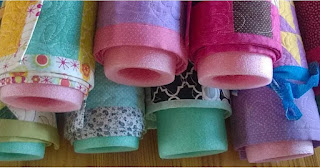How to Take Care Of Your Heirloom Quilt
It’s important to educate yourself, your loved ones and your friends on
proper quilt storage. When taken care of properly, quilts can be passed down through generations. Let's go through some simple tips to keeping your heirlooms in great shape to pass down to your family.
General Do's and Don'ts
Storage
- DON'T store quilts in plastic bags or containers. Plastic cuts off air circulation and gives off harmful by-products as it ages. Mold and mildew can result from moisture trapped inside plastic covers. Static electricity generated by plastic attracts dust. If you have quilts stored in plastic bags in the attic, rescue them NOW!
- DO use well-washed natural cotton or acid-free tissue to protect quilts. (Think pillowcases or towels that have been laundered a gazillion times). It is important to avoid using colored tissue paper. Colored tissue paper contains dyes that can transfer onto the fabric, causing stains and discoloration.
- DON'T store quilts in cardboard boxes; they acidify quickly and are detrimental to some dyes and fibers. Yucky bugs like silverfish are more likely to make a home in a cardboard box and can damage your quilts.
- DON'T store quilts in direct contact with wood, especially unsealed wood like that in cedar chests. Wood, like cardboard, gives off detrimental acids, and quilts need several layers of protective material between wood and fabric.
- DON'T use Mothballs. It’s never a good idea to store your quilts with mothballs. Mothballs leave behind a strong odor and they contain an ingredient that will break down the quilt’s fibers.
- DON'T store anywhere with direct sunlight, like on a wall or guest bedroom. Exposure to UV rays can fade the fabric’s color over time and damage the fabric.
Storage Areas
- DO store quilts within the living area of your home where temperatures and humidity will vary less than in attics, basements and storage units. Quilts should be stored in areas of the home where the temperature and humidity levels are consistent. That means the basement and attic are off limits. Both of these areas tend to have higher humidity levels and extreme temperature fluctuations.
-
Since sunlight and fluorescent light contain rays harmful to quilts.
DO choose an area that is dark most of the time but provides some air circulation.
DO avoid placing on bed (or wall) that sits in direct sunlight.
Rolled Storage
Quilts in good condition can be rolled around a large tube for storage. use a tube at least 3 inches in diameter, rolling the quilt loosely with no wrinkles, and with the top to the outside.
- DO cover the tube with cotton fabric or acid-free tissue. The quilt should not touch bare pasteboard.
- DO use a tube that is longer than the width of the quilt; rolling a folded quilt on a short tube caused severe stress along the fold line.
Pro Tip: Pool Noodles, wrapped in muslin or an old sheet works great!
Flat Storage
A major problem with folding a quilt for flat storage is that the folds create stress on the fabric, stitches and batting. DO pad the folds with crumpled acid-free paper or rolled clean cotton fabric.
- DON'T fold quilts in the same place each time. Fold off-center, and the change the folds at least once a year.
- DO fold quilts as few times as possible, using the largest shelves available.
- DON'T stack heavy quilts as the weight of the top quilts will press folds in the bottom quilts.
Pro Tip: Place a well laundered pillowcase or cotton towel on wood shelf before placing folded quilts on a wood shelf.
Pro Tip: For larger quilts put the noodle ends together, pin fabric scraps if
you don't want to use tape. Roll up the quilt, and cut off the excess
noodle. I put them in two shelving units side by side, that are open on
the ends. Note that most noodles are about 47" long.
Alternative to folding a quilt in the 'usual way'
Hanging a Quilt
- DON'T hang a quilt by nails, staples or pins (or any office supplies). The weight of the quilt should be evenly distributed over the entire width. For best results use ODD number attachments.
- DO Sew a casing along the top of the quilt, from side to side. baste a double layer of a fabric strip to the quilt. A rod will slide between the two layers so it will not touch the quilt fabric.
My favorite method of hanging quilts are on ladder leaning against a wall or an old fashioned quilt rack. Quilts look especially beautiful hung over ladder rungs. They also look nice folded in cabinets.
Read more about
Hanging a Quilt
Cleaning Quilts
A variety of cleaning methods are possible, but not always safe for quilts. DO start with the least complicated, least damaging method.A musty smell often can be diminished by airing quilts outdoors.
- DO air the quilt away from direct sunlight which can have a bleaching effect on colors
(although a hour or so, shouldn't hurt it) - DO use couple of tablespoons of vinegar in the laundry to help eliminate all sorts of funky or musty odors.
- DON'T beat or shake quilts to remove dust. This causes stress that can damage the fabric and stitches as well as loosen batting.
Spot and Stain Removal
Stains that have been in contact with fabric for a long time will be more difficult if not impossible to remove. Attempts to remove some stains are unwise. Rust, blood, and other iron-bearing stains should not be given special treatment because the staining material has probably weakened the fibers.
In general, avoid dry cleaning antique quilts.



